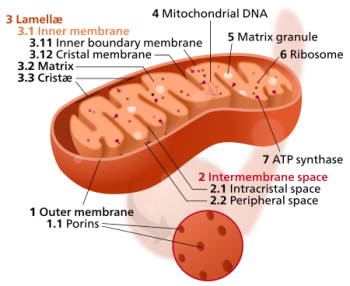We post here frequently about the components of general fitness and physical training goals: strength, athleticism, power, endurance, etc. The variety of exercises that we recommend are stressing and training neuro-muscular and cardiac systems.
However, while we are stressing and challenging our bodies in all of the ways needed for balanced fitness, we are also training our metabolic energy systems for higher capactiy and efficiency. There is no need to know anything about it, but it is interesting.
 It's basic high school biology. Animals (and plants) use ATP as an energy source for cellular functioning. ATP is generated and regenerated in the mitochondria.
It's basic high school biology. Animals (and plants) use ATP as an energy source for cellular functioning. ATP is generated and regenerated in the mitochondria.
However, our resting ATP batteries store very little reserve energy so 5- 20 seconds of high intensity, maximum anaerobic effort (eg 20-second sprints and HIIT sprints, or a set of heavy deadlifts) require instant regeneration of ATP. That's our "emergency" Phosphagen System. After depleted, it takes a couple of minutes to restore itself which is why you rest between deadlift sets or walk ("active recovery") between sprints. The Phosphagen system is trained by stressing it, but it has its limits.
After 10-20 seconds of high intensity, our cells turn to splitting sugar (mainly derived from carbs unless you have a Coke before exercise) - Glycolysis - to produce more ATP. This energy system, also requiring no oxygen, can keep us going for up to 2 minutes of intense effort. Like the Phosphagen system, Glycolysis is trained by short bursts of high intensity exertions of any sort.
A body can't live long, though, without oxygen. Both of the above are anaerobic (oxygen-independent) systems and neither can be sustained for very long without rest and oxygen to restore them. Aerobic exertion (using oxygen to burn sugars and fats - the Aerobic System -) can slowly but almost endlessly produce enough energy to maintain us during less intense activity in which we maintain a pretty good oxygen balance (or at rest, for that matter). Aerobic energy systems are trained and stressed by, say, 1-hour endurance exercises which keep the heart rate continuously well-above a walking heart rate, eg continuous calisthenics, and non-sprinting exercises like swimming speedy but not sprinting laps, treadmill intervals but not HIIT intervals, jogging, and similar exercises when you can breathe uncomfortably but effectively-enough to keep going.
Can aerobic exercise count as "cardio" exercise? Sort-of, maybe. It depends on where you keep your heart rate. High-intensity, high heart-rate bursts are the best heart-stressors and if it doesn't kill you it will make it stronger. Endurance is a different matter. Is normal walking "exercise"? Basically, no. It's just basic functioning unless it's fast and over 5 miles. "Cardio" means heart rate significantly elevated above walking.
Aerobic metabolism is highly efficient, which is why it takes 3 hours on an elliptical to burn the calories (270) in one plain bagel. It is why you can not lose weight by exercising unless you are fast- hiking 8 hrs/day on minimal caloric intake for a week or two. The average sedentary person (meaning under 5-10,000 "steps" daily with no other stressful exercise) probably needs less than 2000 calories per day to maintain their status quo. Remarkably, in the USA, it is not unusual for one single cheap meal to provide that much energy. In all of human history, remarkable indeed. Caloric abundance has a downside, thus the "overweight crisis" especially among our American poor.
A balanced fitness program (resistance, calisthenics, cardio, and endurance) ends up stressing all 3 energy systems without your having to think about it at all. That is just one of the many reasons why we endorse balanced fitness exercise programs instead of a single path (such as all weights, or all aerobics).
Good summary of exercise and energy systems here.


 It's basic high school biology. Animals (and plants) use ATP as an energy source for cellular functioning. ATP is generated and regenerated in the
It's basic high school biology. Animals (and plants) use ATP as an energy source for cellular functioning. ATP is generated and regenerated in the